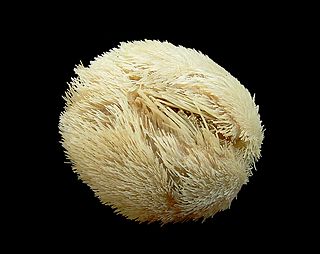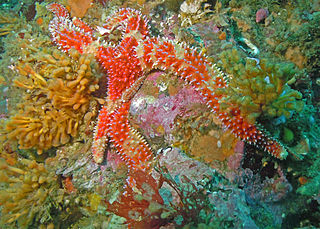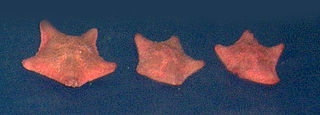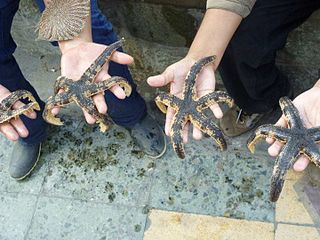
Starfish or sea stars are star-shaped echinoderms belonging to the class Asteroidea. Common usage frequently finds these names being also applied to ophiuroids, which are correctly referred to as brittle stars or basket stars. Starfish are also known as asteroids due to being in the class Asteroidea. About 1,900 species of starfish live on the seabed in all the world's oceans, from warm, tropical zones to frigid, polar regions. They are found from the intertidal zone down to abyssal depths, at 6,000 m (20,000 ft) below the surface.

The Echinasteridae are a family of starfish in the monotypic order Spinulosida. The family includes eight genera and about 133 species found on the seabed in various habitats around the world.

Solaster paxillatus, the orange sun star, is a species of starfish found at varying depths in the northern Pacific Ocean. It is a natural predator of the starfish Asterias amurensis.

The common starfish, common sea star or sugar starfish is the most common and familiar starfish in the north-east Atlantic. Belonging to the family Asteriidae, it has five arms and usually grows to between 10–30 cm across, although larger specimens are known. The common starfish is usually orange or brownish in color, and sometimes violet; specimens found in deeper waters are pale. The common starfish is found on rocky and gravelly substrates where it feeds on mollusks and other benthic invertebrates.

Peringia ulvae, commonly known as the Laver spire shell or mudsnail, is a European species of very small aquatic snail with gills and an operculum, a gastropod mollusk in the family Hydrobiidae.

Henricia is a large genus of slender-armed sea stars belonging to the family Echinasteridae. It contains about fifty species.

Echinocardium cordatum, also known as the common heart urchin or the sea potato, is a sea urchin in the family Loveniidae. It is found in sub-tidal regions in temperate seas throughout the world. It lives buried in the sandy sea floor.
Phaxas pellucidus, the transparent razor shell, is a species of marine bivalve mollusc in the family Pharidae. It is found buried in the seabed in coastal waters of northwest Europe, often in great numbers.

Astropecten irregularis is a sea star of the family Astropectinidae. Common names include Sand sea star.

Orthasterias is a genus of sea stars in the family Asteriidae. Orthasterias koehleri, the rainbow star or red-banded sea star, is the only species in the genus. It is found in the North Pacific Ocean.

Asterina gibbosa, commonly known as the starlet cushion star, is a species of starfish in the family Asterinidae. It is native to the northeastern Atlantic Ocean and the Mediterranean Sea.

Sea star wasting disease or starfish wasting syndrome is a disease of starfish and several other echinoderms that appears sporadically, causing mass mortality of those affected. There are approximately 40 species of sea stars that have been affected by this disease. At least 20 of these species were on the Northwestern coast of Mexico to Alaska. The disease seems to be associated with increased water temperatures in some locales, but not others. It starts with the emergence of lesions, followed by body fragmentation and death. In 2014 it was suggested that the disease is associated with a single-stranded DNA virus now known as the sea star-associated densovirus (SSaDV). However, this hypothesis was refuted by recent research in 2018 and 2020. Sea star wasting disease is still not fully understood.

Marthasterias is a genus of starfish in the family Asteriidae. Both species in the genus are commonly known as the spiny starfish.
Henricia lisa is a species of starfish in the family Echinasteridae found in deep water in the northern Atlantic Ocean.

Luidia magellanica is a species of starfish in the family Luidiidae. It is found in the southeastern Pacific Ocean on the coast of South America.

Henricia sexradiata is a species of starfish in the family Echinasteridae. It is native to the western Atlantic Ocean and the Gulf of Mexico.

Henricia ornata, the reticulated starfish, is a species of starfish in the family Echinasteridae. It is native to the southeastern Atlantic Ocean on the coast of South Africa, the type locality being the Cape of Good Hope.
Asterocheres lilljeborgi is a species of copepod in the family Asterocheridae. It is found in the British Isles and Scandinavia where it is a semi-parasite of starfish. First described as Asterocheres lilljeborgi in 1859 by the Norwegian marine biologist Jonas Axel Boeck, it is the type species of the genus.

Henricia pumila, commonly known as the dwarf mottled henricia, is a species of blood star, a starfish in the family Echinasteridae.
















